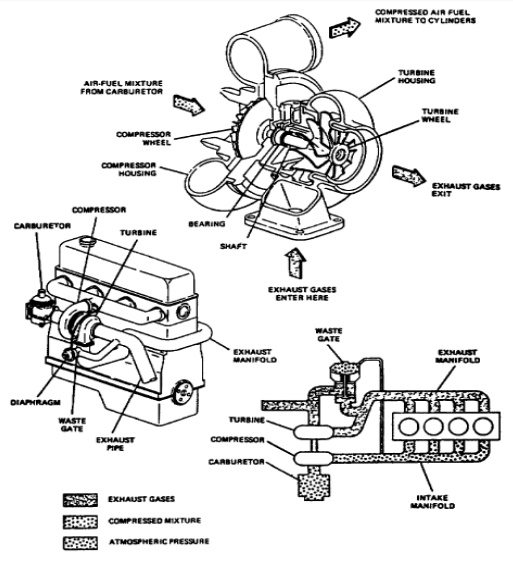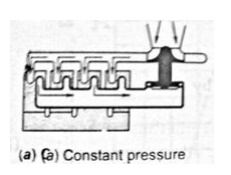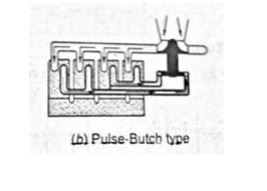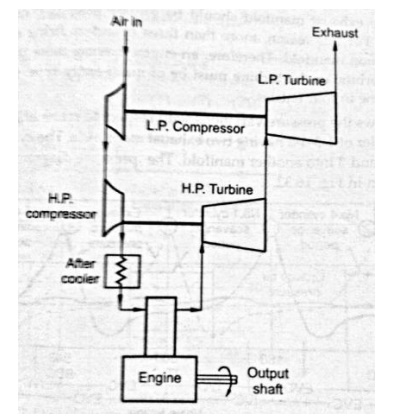Chapter: Mechanical : Advanced IC Engines : Compression Ignition Engines
Turbo Chargers
TURBO CHARGERS
Turbocharging:
Turbocharging
is a method of increasing engine volumetric efficiency by forcing the air fuel
mixture into the intake rather than merely allowing the pistons to draw it in
naturally.
Turbocharger:
A
turbocharger uses the force of the engine exhaust stream to force the air fuel
mixture into the engine. It consists of a housing containing two chambers. One
chamber contains a turbine that is spun as hot exhaust gases are directed
against it. The turbine shaft drives an impeller that is located in the other
chamber. The spinning impeller draws an air fuel mixture from the carburetor
and forces it into the engine. Because the volume of exhaust gases increases
with engine load and speed, the turbocharger speed will increase
proportionally, keeping the manifold pressure fairly uniform. A device known as
a waste gate is installed on turbocharged engines to control manifold pressure.
It is a valve which, when open, allows engine exhaust to bypass the turbocharger
turbine, effectively reducing intake pressure. The waste gate valve is operated
bya diaphragm that is operated by manifold pressure. The diaphragm will open
the waste gate valve whenever manifold pressure reaches the desired maximum.

Different types of Turbo-charging:
There are
different types of turbo charging, they are
1. Constant
pressure turbo-charging.
2. Pulse
turbo charging (Buchi-type)
3. Pulse
convertor turbo-charging.
4. Complex
supercharger.
5. Two stage
supercharger.
Constant pressure turbo-charging:
In this
system, the exhaust pressure of the engine is constant and higher than
atmospheric pressure so that the turbine can operate at an optimum efficiency.
The objective dictates a large exhaust manifold to absorb pressure fluctuation
and therefore the kinetic energy in the exhaust blow down is dissipated and
becomes a reheat factor. This arrangement is shown in figure below.

The
exhaust gases from the entire cylinder are released through exhaust valve at a
constant pressure in the common manifold and then to turbine. The blow-down
energy in the form of internal energy is converted into work in the turbine.
The recovery of blow down energy is higher if the pressure ratio of the turbine
is high.
Advantages:
1. The
pressure ratio is higher in turbine and compressors; the recovery of exhaust
energy is efficient and is lower than other systems.
2. The
turbine runs at higher efficiency because of constant pressure and temperature
of the exhaust gases supplied to the turbine. This method is more efficient and
effective than pulse system if the pressure ratio is 3 or higher.
3. The
exhaust piping arrangement is very simple for multi cylinder engines and highly
efficient turbine can be used.
4. Engine
speed is no limited by the pressure waves in the exhaust pipes.
5. Exhaust
manifold being large to hold pressure fluctuations with ±5%, the pipe diameter
is kept 1.4 times piston diameter. However, the insulation of exhaust manifold
is essential to preserve the temperature of exhaust gases.
Disadvantages:
1. As the
pressure in the exhaust manifold is maintained constant, this requires larger
diameter of exhaust pipes. This effect is marked in case of small engines.
2. The
response of the system to the load change is considerably poor. Because,
acceleration occurs very slowly when load is suddenly increased. This is
because, only a small amount of energy due to increased exhaust temperature is
available to accelerate the engine at high loads.
3. For
higher efficiency of the turbine, the higher pressure drop in the turbine is
required.
To
achieve this, large pressure drop during release is required which makes
scavenging a bit difficult (p2 / p1) is necessary and do
not require acceleration and operation at part loads.
4. The part
load ɳ of the turbine is reduced due to partial admission to the turbine.
5. This
system is not suitable at all suitable for two strokes engines as it is
impossible to run the compressor with the help of turbo charger alone and some
additional means have to be provided for supplying the air to the engine.
Pulse turbo charging (Buchi-type):
The main
objective of this system is to use the kinetic energy in the blow-down process
to drive the turbine without increase in exhaust pressure. To accomplish this
objective, the exhaust lines must be small and grouped to receive the exhaust
pressure. To accomplish this objective, the exhaust lines must be small and
grouped to receive the exhaust from cylinders which are blowing down at
different times. This arrangement is shown in figure below.

Advantages:
1. The
recovery system of the exhaust blow-down energy is more efficient is more
efficient than constant pressure system.
2. Separate
exhaust pipes are used so that the exhaust process of various cylinders do not
interfere with one another. A common exhaust pipe can also be used for those
cylinders whose exhaust cycles do not overlap significantly in terms of times.
3. The space
required is less due to short and smaller diameter pipes.
4. Rapid
acceleration of turbo charger to a higher speed can be fed to the turbine
without delay.
5. Better
scavenging can be obtained at low load due to reduced pressure in the exhaust
manifold.
Disadvantages:
1. The
recovery of energy is poor when the pressure ratio of turbine is high.
2. Complicated
inlet and exhaust piping is required with the multi-cylinder engines.
3. The
turbine efficiency becomes poor in case of one or two cylinder engines.
4. The
scavenging process is disturbed if the waves have to travel long distance to
reach to the turbine.
Application:
1. This
system is widely used for low pressure ratio turbines and rapidly acceleration
is required.
2. This is
generally used when numbers of cylinder are four or more and connected to a
common exhaust pipe.
Pulse converter turbo-charging:
The pulse
convertor has the advantages of pulse and the constant pressure turbo-charging
to be used simultaneously and avoids most of the drawbacks of both.
A
constant pressure turbo-charging requires steady flow for maximum efficiency
whereas pulse type turbo-charging operates relatively at lower efficiency due
to partial operation. But pulse supercharging operates most efficiently at part
load-condition and provides good scavenging also.
Therefore,
a combination of two systems is essential for good efficiency during overall
operation of the engine. This is done by connecting different branches of
exhaust manifolds together in a specially designed for maximum pulse-system
designed for maximum pulse utilisation is retained and the turbine run at full
admission conditions to provide good efficiency.

Complex Supercharger:
The
characteristics of turbo-chargers are fundamentally different from those
reciprocating I.C engines and leads to complex matching problems when they are
combined. Supercharger has added complication of mechanical drive and the
compressor efficiencies are usually such that the overall economy is reduced.
However, flow characteristics are better matched and transient response is
good.
The pressure
wave superchargers make use of the fact of two fluids having different
pressures are bought into direct contact in long narrow channels; equalization
of pressure occurs faster mixing. One such device, the complex, has been
developed for I.C engine super-charging which operates using this principle.

Two stage supercharger:
For
diesel engines, high supercharging is required as 25 to 30 bar BMEP is
expected. This cannot be obtained in a single stage turbo-charging so a two
stage is used as shown in figure given below.

Advantages:
1. High
pressure ratio can be obtained and provides wide range of operation.
2. The
efficiency of two stages turbo-chargedis higher than single because of higher
boost ratio. This gain is further increased by introducing after-cooler.
3. Better
matching of turbocharger to engine operating conditions is possible.
4. The
transient response of two stages turbo-charged is better than single stage.
Disadvantages:
1. The space
requirement is higher.
2. It is
heavier and costs higher.
3. Matching
of turbo-charged with engine is quite difficult.
Related Topics